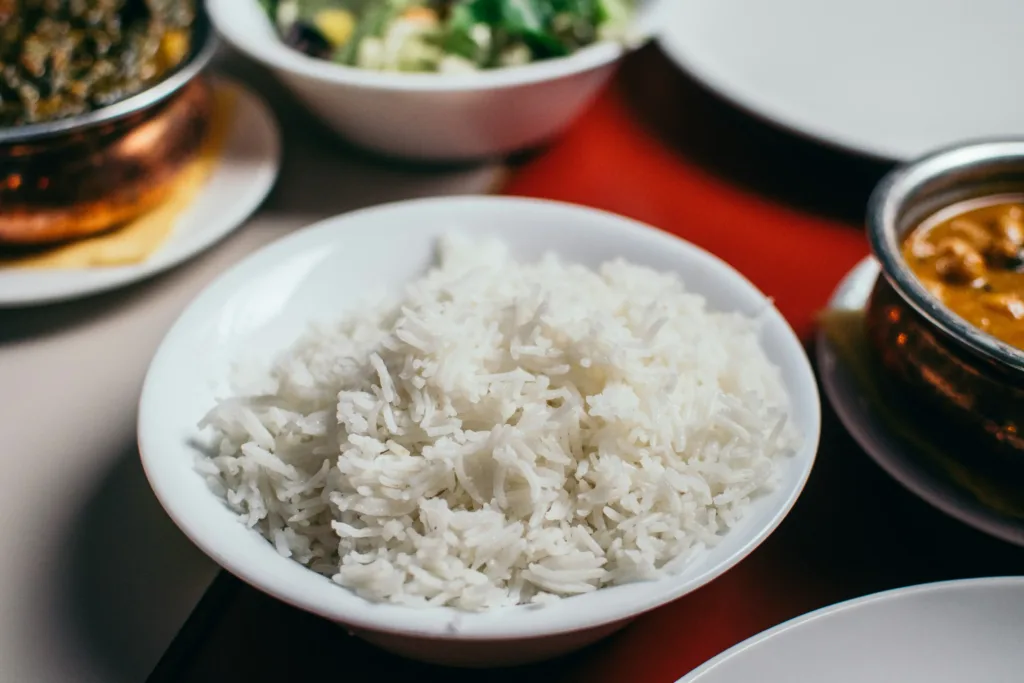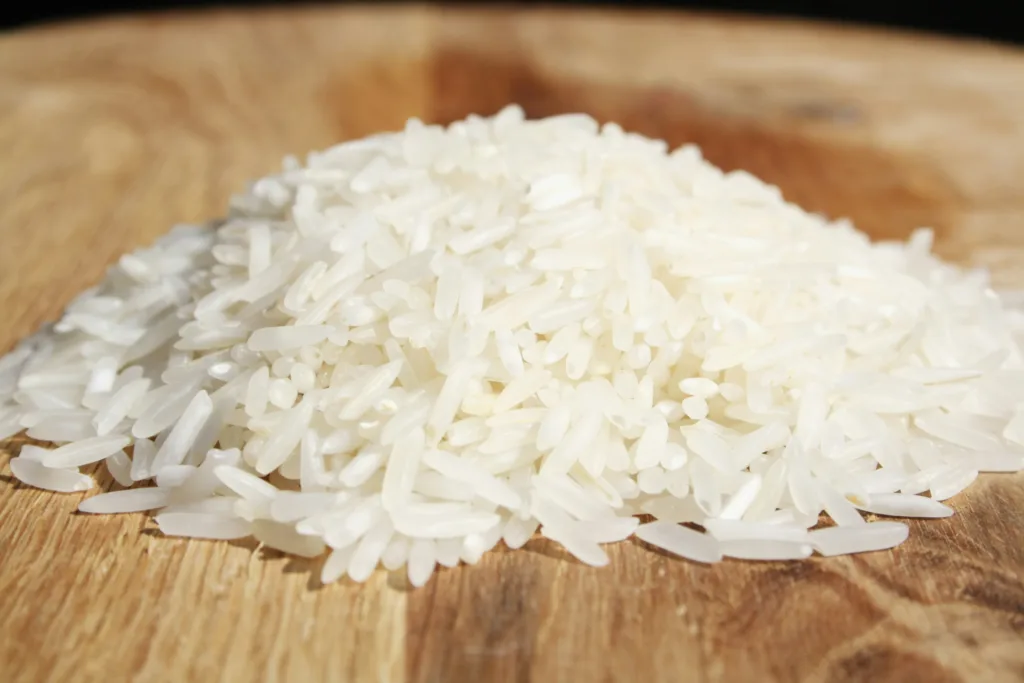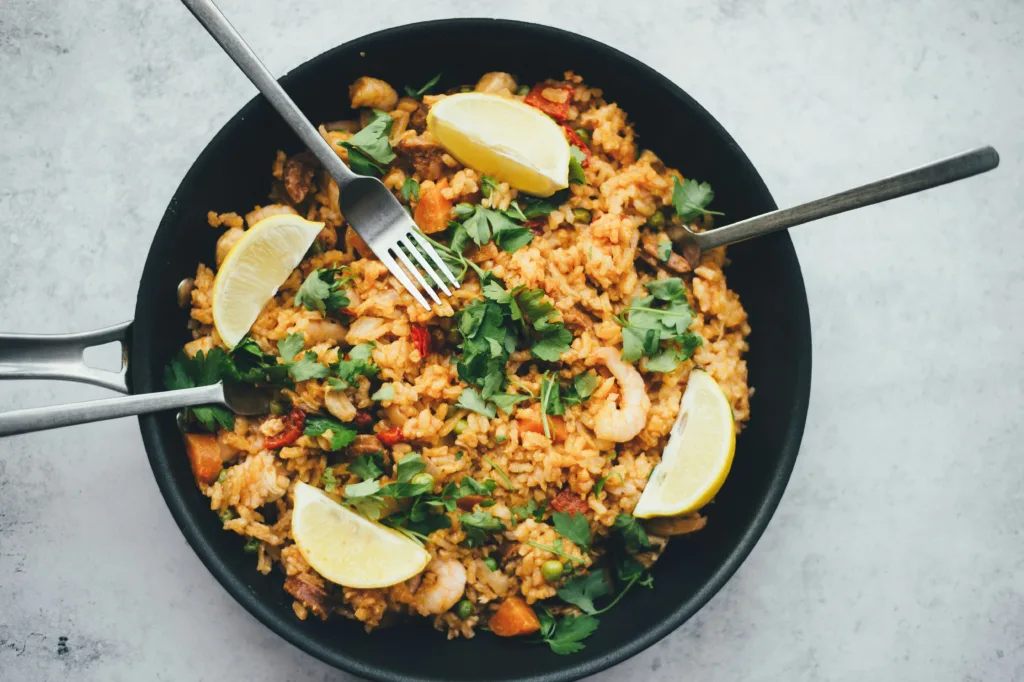Jasmine rice is one of those ingredients that’s always hanging around in someone’s pantry. It smells amazing when it’s cooking, works with pretty much anything, and is quick enough to save dinner on a busy night. But once you start thinking more about what goes on your plate, that little voice pops up: “Is jasmine rice actually good for me?”
If you’re wondering whether this fluffy, fragrant grain is a smart choice for your meals, you’re not alone. There’s a lot of info floating around, and not all of it is clear. Some say it’s packed with nutrients, others say it’s a blood sugar bomb. So let’s clear it up with a practical, honest breakdown of what jasmine rice really offers from a nutrition and lifestyle point of view.
If you’re testing out new jasmine rice recipes or tweaking your go-to rice bowl, our app ReciMe makes it easy to save, organize, and actually find them again later. Instead of juggling screenshots, links, or scattered notes, you can use the app to keep everything in one spot, whether it’s something we saved from TikTok or uploaded ourselves. It works across iOS, Android, and even as a Chrome Extension, so it’s easy to plan meals, build grocery lists, and stay on track without overcomplicating things.


The Basics: What Even Is Jasmine Rice?
Jasmine rice is a type of long-grain rice that originally comes from Thailand. What makes it different from standard white rice is its slightly floral aroma, soft texture, and tendency to cling just a little after cooking. It’s often used in Thai and Vietnamese cuisine, but it’s definitely crossed borders and now shows up in everything from poke bowls to meal prep containers.
You’ll usually find two main types on store shelves:
- White jasmine rice (refined and polished)
- Brown jasmine rice (whole grain, less processed)
There’s also red jasmine rice, which is less common but packed with color and nutrients. We’ll get to that in a bit.

White vs Brown vs Red: The Real Differences
If you’re staring at rice bags in the grocery store wondering which one to grab, here’s a simple breakdown:
White Jasmine Rice
- Soft, fluffy texture
- Mild flavor
- Lower in fiber and nutrients
- Higher glycemic impact
- Fast to cook
Brown Jasmine Rice
- Chewier texture
- Slightly nutty taste
- Higher in fiber (good for digestion and fullness)
- Contains more iron and magnesium
- Cooks slower
Red Jasmine Rice
- Rich color due to natural antioxidants
- Highest in nutrients of the three
- Chewy and hearty texture
- May be harder to find
- Slightly longer cook time
If you’re going for nutrition density, brown or red jasmine rice is the better choice. If you want something that blends easily into meals and is kid-approved, white jasmine rice still works, just pair it smartly.
Nutritional Profile: What’s Actually Inside?
Here’s the general breakdown for one cup of cooked white jasmine rice:
- Calories: around 205
- Carbs: 45 grams
- Protein: 4 grams
- Fat: less than 1 gram
- Fiber: about 1 gram
- A few small amounts of minerals like iron, calcium, and B vitamins
In other words, jasmine rice is mostly carbohydrates, low in fat, and light on protein and fiber. That’s not necessarily a bad thing, but it does mean it plays a very specific role in a balanced diet: energy.
If you switch over to brown jasmine rice, you get more fiber (about 4 grams per cup), a little more iron, and a few more vitamins because the outer bran layer is still intact. It’s still rice, but with more staying power.

Is It Good for You? Yes, But It Depends
Here’s the honest answer: jasmine rice can absolutely be part of a healthy diet, but it’s not a superfood or a one-size-fits-all solution.
It’s great when you:
- Need quick energy before or after a workout
- Are looking for a neutral-tasting base for dishes
- Want a naturally gluten-free grain
- Are cooking for picky eaters or people with sensitive stomachs
It’s not ideal if you:
- Need to control blood sugar very closely
- Are trying to lose weight by focusing on high-fiber, high-protein foods
- Tend to eat rice in huge portions without anything else on the plate
As always, context matters. Rice alone doesn’t make or break your nutrition goals. It’s what you serve it with, how much you eat, and how often it shows up in your meals.
Pros and Cons, Realistically
Let’s boil it down to what actually matters.
Pros:
- Easy to digest
- Naturally gluten-free
- Quick to cook
- Works with nearly any cuisine
- Brown and red versions are packed with fiber and antioxidants
- Inexpensive and shelf-stable
Cons:
- White jasmine rice is low in fiber
- Can raise blood sugar if eaten alone in large amounts
- Contains arsenic (like most rice)
- Not very filling compared to whole grains

Let’s Talk About Blood Sugar
One of the most common concerns with jasmine rice is how it affects blood sugar. Since it’s high in simple carbohydrates, white jasmine rice can cause a faster rise in blood glucose than some other grains.
This is especially important for:
- People with diabetes or prediabetes
- Anyone trying to manage energy dips during the day
- Those looking for slower-digesting foods to stay full longer
But there’s a catch: glycemic impact doesn’t just depend on the rice. It depends on the full meal. Add fiber, protein, or healthy fat, and your body processes the rice much more slowly. For example, a rice bowl with chicken and veggies is going to hit very differently than a plain bowl of white rice on its own.
What About Arsenic?
Yeah, let’s talk about the awkward topic of arsenic. All rice, including jasmine rice, naturally contains small amounts of arsenic. It gets into the grain through the soil and water used in rice farming. Jasmine rice isn’t excluded from this, and in some cases, it’s been found to have slightly more arsenic than basmati rice.
But before you start rethinking every rice-based meal you’ve ever had, here’s the important part: the levels of arsenic found in most commercially available rice aren’t considered harmful if you’re eating rice in moderation. That means enjoying it a few times a week as part of a balanced diet is totally fine for most people.
If you want to lower the arsenic content further, rinsing the rice before cooking and boiling it in excess water, then draining it (kind of like you’d cook pasta), can cut the levels down significantly. It’s a small tweak that doesn’t take much effort but can make a difference over time. And just like with anything, variety is key. If rice is your go-to grain, try rotating in others like quinoa, farro, or even couscous here and there.
The FDA still considers rice safe to eat, especially when it’s not your only grain source and you’re not eating it multiple times a day, every day. So no, you don’t have to quit jasmine rice altogether. Just be smart about how often it’s on your plate and how you prepare it.

How to Make Jasmine Rice Work in a Healthy Diet
Here’s the part most people skip: how to use jasmine rice in a way that supports your goals. It’s not about cutting it out entirely. It’s about how you serve it.
A few solid tips:
- Mix in other grains like quinoa or lentils for extra fiber and protein
- Use it as a side, not the whole meal
- Bulk it up with veggies, beans, or lean protein
- Try brown jasmine rice if you want a more nutrient-dense option
- Cook with broth instead of plain water for extra flavor without extra calories
Portion control also matters more than we think. One cup of cooked rice is enough for most people, especially if the plate has other components.
Meal Ideas Using Jasmine Rice
Not sure where to start? Here are some meal ideas that let jasmine rice shine while keeping things balanced:
- Jasmine Rice Bowl with Grilled Chicken and Roasted Veggies
- Spicy Tofu Stir-Fry with Brown Jasmine Rice
- Shrimp and Mango Salad with a Scoop of Rice
- Coconut Jasmine Rice with Black Beans and Cilantro
- Breakfast Rice Porridge with Berries and Almonds
These meals are easy to prep, reheat well, and can be adjusted based on what you’ve got in the fridge.
Final Thoughts
So, is jasmine rice healthy? The short answer is yes, but not in a magical, fix-everything kind of way. It’s a perfectly good grain that brings flavor, flexibility, and comfort to the table. The white version is a solid choice when you want something quick and easy, especially if you’re pairing it with fiber-rich veggies or lean protein. Brown and red jasmine rice take it a step further if you’re after more fiber and nutrients.
No grain needs to be perfect to be useful. What matters is how it fits into the bigger picture of what you eat and how you eat it. Jasmine rice can absolutely support your goals when it’s part of a balanced, realistic meal plan. Whether you’re cooking for the week or just throwing together a fast dinner, it’s one of those pantry staples that earns its place again and again.
FAQs
Can jasmine rice be eaten every day?
Technically, yes, you can eat jasmine rice daily. But like any grain, it’s better to rotate your carbs to get a mix of nutrients. Swapping in brown rice, quinoa, or even barley a few days a week can keep things balanced.
Is jasmine rice better than white rice?
They’re actually pretty similar when it comes to basic nutrition. The main differences are in taste and texture. If you want more fiber and minerals, brown jasmine rice is a better pick than regular white rice.
Does jasmine rice help with weight loss?
On its own, probably not. But it can fit into a weight loss plan if the portions are reasonable and you’re building meals that include protein, veggies, and healthy fats. Brown jasmine rice can be more filling, thanks to the fiber.
Is jasmine rice OK for people with diabetes?
It depends on how it’s eaten. White jasmine rice has a higher glycemic impact, so pairing it with protein and fiber is important. If you’re managing blood sugar closely, brown jasmine rice or smaller portions might be better.
Can I use jasmine rice in place of other grains?
Definitely. It’s versatile enough to swap in for white rice, couscous, or even pasta in a pinch. Just keep in mind the texture is a bit different, and it absorbs flavors really well, so it works best in dishes with sauce or seasoning.
How do I reduce arsenic in jasmine rice?
The easiest way is to rinse it well before cooking and boil it in extra water, then drain it like pasta. That simple method can lower arsenic levels by a good amount.
